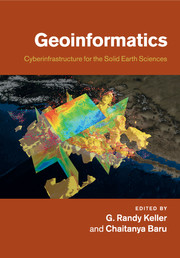Book contents
- Frontmatter
- Contents
- List of contributors
- Preface
- Introduction
- Part I Case studies from other disciplines
- Part II Modeling software and community codes
- Part III Visualization and data representation
- Part IV Knowledge management and data integration
- Part V Web services and scientific workflows
- 12 Service orientation in the design of a community hydrologic information system
- 13 Web services for seismic data archives
- 14 Development of robust data system for gravity and magnetic anomaly data: A case study of a community-based effort for point data
- 15 Scientific workflows for the geosciences: An emerging approach to building integrated data analysis systems
- 16 Online access and processing of LiDAR topography data
- 17 Use of abstraction to support geoscientists' understanding and production of scientific artifacts
- Part VI Emerging international and other efforts
- Index
- Plate section
- References
16 - Online access and processing of LiDAR topography data
from Part V - Web services and scientific workflows
Published online by Cambridge University Press: 25 October 2011
- Frontmatter
- Contents
- List of contributors
- Preface
- Introduction
- Part I Case studies from other disciplines
- Part II Modeling software and community codes
- Part III Visualization and data representation
- Part IV Knowledge management and data integration
- Part V Web services and scientific workflows
- 12 Service orientation in the design of a community hydrologic information system
- 13 Web services for seismic data archives
- 14 Development of robust data system for gravity and magnetic anomaly data: A case study of a community-based effort for point data
- 15 Scientific workflows for the geosciences: An emerging approach to building integrated data analysis systems
- 16 Online access and processing of LiDAR topography data
- 17 Use of abstraction to support geoscientists' understanding and production of scientific artifacts
- Part VI Emerging international and other efforts
- Index
- Plate section
- References
Summary
Introduction
Real-time sensor networks, space and airborne-based remote sensing, real-time geodesy and seismology, massive geospatial databases, and large computational models are all enabling new and exciting research on the forefront of the earth sciences. However, with these technologies comes a prodigious increase in the volume and complexity of scientific data that must be efficiently managed, archived, distributed, processed, and integrated in order for it to be of use to the scientific community. Data volume, processing expertise, or computing resource requirements may be a barrier to the scientific community's access to and effective use of these datasets. An emerging solution is a shared cyberinfrastructure that provides access to data, tools, and computing resources. A key objective of geoinformatics initiatives (e.g., Sinha, 2000) is to build such cyberinfrastructure for the geosciences through collaboration between earth scientists and computer scientists.
Airborne LiDAR (Light Distance And Ranging) data have emerged as one of the most powerful tools available for documenting the Earth's topography and its masking vegetation at high resolution (defined here as pixel dimensions less than 2 meters). LiDAR-derived digital elevation models (DEMs) are typically of a resolution more than an order of magnitude better than the best-available 10-meter DEMs. The ability to use these data to construct 2.5-D and 3-D models of the Earth's topography and vegetation is rapidly making them an indispensable tool for earth science research (e.g., Carter et al., 2001).
- Type
- Chapter
- Information
- GeoinformaticsCyberinfrastructure for the Solid Earth Sciences, pp. 251 - 265Publisher: Cambridge University PressPrint publication year: 2011
References
- 5
- Cited by



